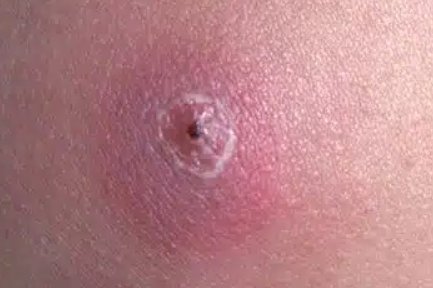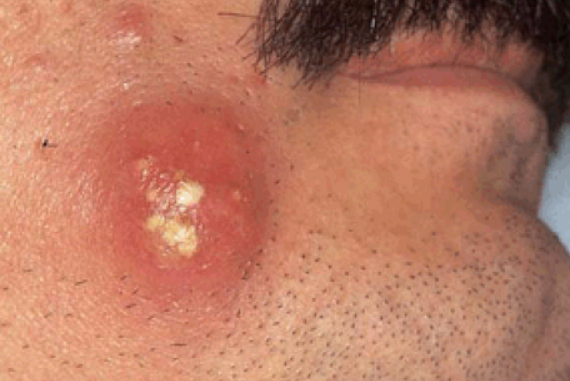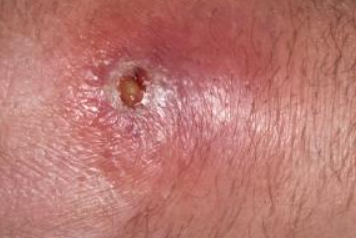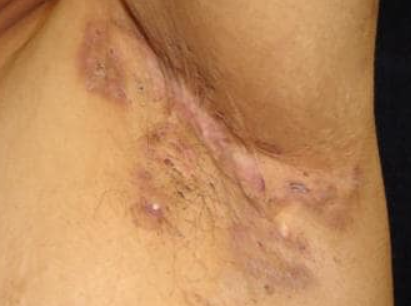Deep staphylococcal skin infections are a group of bacterial infections caused by staphylococci.
The most common pathogens are Staphylococcus aureus, S. haemolyticus, and S. epidermidis. The pathogenic properties of these microorganisms are determined by their ability to produce toxins, enzymes, and other biologically active substances during their life cycle. Staphylococcal infections with toxic skin damage accompanied by exfoliation are usually caused by Staphylococcus strains from phage group II, which are lysed by phages 3A, 3B, 3C, 55, and 71.
Other microorganisms such as Proteus vulgaris, pneumococci, and streptococci may also be etiologic agents and typically occur in association with staphylococci. In the epidemiology of staphylococcal infections, staphylococcal carriage is considered to play an important role.
Exogenous factors that contribute to the development and recurrence of staphylococcal skin infections include disruption of epidermal integrity (microtrauma, skin maceration), skin contamination, increased sweating, shifts in skin pH toward alkalinity, and exposure to high and low temperatures.
Endogenous risk factors for the disease include various endocrinopathies, especially disorders of carbohydrate metabolism (diabetes mellitus), insufficient protein intake, the presence of serious somatic diseases, hypovitaminosis, chronic intoxications, and the presence of staphylococcal infection foci in various organs and tissues.Boil (furuncle)
Carbuncle
Skin Abscess
Abscess of the Newborn
Hidradenitis suppurativa
The diagnosis is made based on the clinical manifestations of the disease.
Laboratory investigations may include:
- Bacteriological culture of purulent discharge with sensitivity to antibiotics.
- Blood glucose level.
- Complete blood count.
- Acne cysts – Usually multiple on the upper trunk, neck, and face.
- Ruptured epidermoid cyst
- Arthropod bites
- Abscess
- Atypical mycobacterial infections
- Sporotrichosis – Commonly more chronic and with lymphatic spread.
- Mycobacterium marinum
- Furunculosis
- Folliculitis
- Carbuncles
- Epidermoid cysts
- Abscesses, including recurrent Staphylococcus aureus infection and MRSA
- Cellulitis
- Pilonidal sinus (gluteal cleft)
- Candidiasis
- Ulcerative colitis (genital region)
- Pyoderma gangrenosum
- Bartholin gland abscess (genital region)
- Sebaceous adenitis
- Crohn disease (perianal)
- Perianal fistula (perianal)
- Granuloma inguinale (genital region)
- Actinomycosis.
- Lymphogranuloma venereum (genital region)
- Tularemia
- Cat-scratch disease
General notes on therapy
- For superficial forms of bacterial infection, it is recommended to use topical antiseptics, aniline dyes, and topical antibiotics.
- Systemic antibiotics are prescribed for extensive, deep, chronic, recurrent bacterial infections, in the absence of improvement with topical therapy, in the presence of systemic symptoms (fever, malaise), and regional complications (lymphadenitis, lymphangitis), or when deep bacterial infections are located on the face.
- Systemic glucocorticoids are prescribed when the pathological process is highly active, in cases of chronic ulcerative and vegetative, and gangrenous pyodermas.
- Systemic retinoids are prescribed for keloid acne, perifolliculitis capitis abscedens et suffodiens.
- Immunobiological agents are prescribed for recurrent, persistently progressive forms of bacterial infections.
- The management of patients with bacterial infections includes proper skin care both in the affected area and outside of it. For disseminated processes, frequent water procedures and hair removal by shaving are not recommended. It is advisable to trim the hair in the infected area.
- In the case of prolonged infectious and inflammatory processes, as well as in the case of multiple eruptions, attention should be paid to the diet: it should be balanced, rich in vitamins, with a sharp reduction in salt and carbohydrates, and complete avoidance of alcohol.
Indications for hospitalization
- Diseases associated with the action of toxin-producing Staphylococcus and Streptococcus.
- Widespread eruptions accompanied by a disturbance in the general condition.
Requirements for treatment outcomes
- Resolution of pathological skin elements.
- Epithelialization and scarring of ulcers.
- Reduction in the frequency of disease recurrence in cases of chronic bacterial infection.
Prevention
- Primary prevention of bacterial infection consists of timely antiseptic treatment of microtraumas, fissures and wounds. Treatment of identified systemic diseases that may lead to purulent lesions of the skin (diabetes mellitus, gastrointestinal diseases, respiratory diseases, etc.) should also be performed.
Topical therapy
Antiseptic preparations for external use:
- Brilliant green solution, 1% alcohol solution applied to the rash area 2-3 times a day for 7-14 days, or
- Fukorcin, alcohol solution applied to the rash area 2-3 times a day for 7-14 days, or
- Methylene blue, 1% aqueous solution applied to the rash area 2-3 times a day for 7-14 days, or
- Potassium permanganate, 0.01-0.1% aqueous solution applied to the rash area 2-3 times a day for 7-14 days, or
- Hydrogen peroxide solution, 1-3% applied to the rash area 2-3 times a day for 7-14 days, or
- Chlorhexidine, 0.5% alcohol solution, 0.05-1% aqueous solution applied to the rash area 2-3 times a day for 7-14 days, or
- Povidone-iodine solution, 10% applied to the rash area 2-3 times a day for 7-14 days.
Topical antibiotics:
- Neomycin sulfate + zinc bacitracin applied to the rash area 2-3 times a day for 7-14 days, or
- Gentamicin sulfate, 0.1% ointment or cream (d) applied to the rash area 3-4 times a day for 7-14 days, or
- Fusidic acid, 2% cream or ointment applied to the rash area 3-4 times a day for 7-14 days, or
- Mupirocin, 2% ointment applied to the rash area 2-3 times a day for 7-14 days, or
- Erythromycin, ointment (10,000 IU/g) applied to the rash area 2-3 times a day for 7-14 days, or
- Lincomycin hydrochloride, 2% ointment applied to the rash area 2-3 times a day for 7-14 days, or
- Silver sulfadiazine, 1% cream applied to the rash area 1-2 times a day for 7-10 days for 7-14 days. (Low evidence)
Topical glucocorticoids combined with antibacterial preparations:
Prescribed in cases of acute inflammatory processes accompanied by erythema, swelling, itching, and more often in the presence of itchy dermatoses complicated by secondary bacterial infection:
- Tetracycline hydrochloride + triamcinolone acetonide, aerosol applied to the rash area 2-4 times a day for 5-10 days, or
- Hydrocortisone acetate + oxytetracycline hydrochloride, ointment, aerosol applied to the rash area 1-3 times a day for 5-10 days, or
- Fusidic acid + betamethasone, cream applied to the rash area 2-3 times a day for 7-14 days, or
- Fusidic acid + hydrocortisone, cream applied to the rash area 3 times a day for 7-14 days, or
- Betamethasone valerate + gentamicin sulfate, cream, ointment (B) applied to the rash area 1-2 times a day for 7-14 days, or
- Betamethasone dipropionate + gentamicin sulfate, cream, ointment (B) applied to the rash area 2 times a day for 7-14 days.
Systemic therapy
Penicillin group antibiotics:
- Benzylpenicillin sodium salt: for children - 25,000-50,000 IU per kg of body weight per day intramuscularly, for adults - 2,000,000-12,000,000 IU per day intramuscularly. The drug is administered every 4-6 hours for 7-10 days, or
- Amoxicillin trihydrate: for children under 2 years of age - 20 mg per kg of body weight per day orally, for children aged 2 to 5 years - 125 mg 3 times a day orally, for children aged 5 to 10 years - 250 mg 3 times a day orally, for children older than 10 years and adults - 500 mg 3 times a day orally. The course of treatment is 7-10 days, or
- Amoxicillin: for children under 3 years of age - 30 mg per kg of body weight per day in 2-3 doses orally, for children aged 3 to 10 years - 375 mg twice a day orally, for children older than 10 years and adults - 500-750 mg twice a day orally. The course of treatment is 7-10 days, or
- Amoxicillin trihydrate + clavulanic acid: for children aged 3 months to 1 year - 2.5 ml of suspension 3 times a day orally, for children aged 1 to 7 years - 5 ml of suspension 3 times a day orally, for children aged 7 to 14 years - 10 ml of suspension or 5 ml of suspension forte 3 times a day orally, for children older than 14 years and adults - 1 tablet (250 + 125 mg) 3 times a day or 1 tablet (500 + 125 mg) 2 times a day orally. The course of treatment is 7-10 days.
Cephalosporin group antibiotics:
- Cephalexin: for children with a body weight of less than 40 kg - 25-50 mg per kg of body weight per day orally, for adults and children older than 10 years - 250-500 mg orally 4 times a day. The course of treatment is 7-14 days, or
- Cefazolin: for children - 20-40 mg per kg of body weight per day intramuscularly or intravenously, for adults - 1 g per day intramuscularly or intravenously. Frequency is 2-4 times a day. The course of treatment is 7-10 days, or
- Cefaclor: for children under 6 years of age - 30 mg per kg of body weight per day orally in 3 doses, for children aged 6 to 10 years - 250 mg orally 3 times a day, for children older than 10 years and adults - 500 mg orally 3 times a day. The course of treatment is 7-10 days, or
- Cefuroxime: for children - 125-250 mg orally 2 times a day, for adults - 250-500 mg orally 2 times a day. When administered parenterally: for children under 3 months of age - 30 mg per kg of body weight (daily dose) 2-3 times a day, for children older than 3 months - 60 mg per kg of body weight (daily dose) 3-4 times a day, for adults - 750 mg-1.5 g 3 times a day. The course of treatment is 7-10 days, or
- Cefotaxime: for children weighing less than 50 kg - 50-100 mg per kg of body weight per day intravenously or intramuscularly with an injection interval of 6-8 hours, for children weighing more than 50 kg and adults - 2.0-6.0 g per day intravenously or intramuscularly with an injection interval of 8-12 hours. The course of treatment is 5-10 days, or
- Ceftriaxone: for children under 12 years of age - 50-75 mg per kg of body weight once a day intramuscularly, for children older than 12 years and adults - 1.0-2.0 g once a day intramuscularly. The course of treatment is 7-10 days.
Macrolide group antibiotics:
- Erythromycin: for children under 3 months of age - 20-40 mg per kg of body weight per day, for children aged 3 months to 18 years - 30-50 mg per kg of body weight per day, for adults - 1.0-4.0 g orally per day in 4 doses. The course of treatment is 5-14 days, or
- Azithromycin: for children - 10 mg per kg of body weight once a day orally for 3 days, for adults - 500 mg orally once a day for 3 days, or
- Clarithromycin: for children - 7.5 mg per kg of body weight per day orally, for adults - 500-1000 mg orally per day. The dosing frequency is 2 times a day. The course of treatment is 7-10 days.
Tetracycline group antibiotics:
- Doxycycline: for children over 12 years of age and/or with a body weight of less than 50 kg - 4 mg per kg of body weight once a day on the first day, 2 mg per kg of body weight once a day on subsequent days; for children over 12 years of age and/or with a body weight of more than 50 kg and adults - 100 mg orally twice a day for 10-14 days.
Fluoroquinolone group antibiotics:
- Ciprofloxacin: 250-500 mg orally twice a day for 5-15 days, or
- Levofloxacin: 250-500 mg orally 1-2 times a day for 7-14 days, or
- Ofloxacin: 200-400 mg orally twice a day for 7-10 days.
Antibiotics of the lincosamide group:
- Clindamycin: for children - 3-6 mg per kg of body weight orally 4 times a day, for adults - 150-450 mg orally 4 times a day; when administered parenterally, for children - 15-40 mg per kg of body weight per day, for adults - 600 mg-2.7 g per day, administered 3-4 times a day. The course of treatment is 10 days.
Sulfonamide antibiotics:
- Sulfamethoxazole + trimethoprim: for children aged 3 to 5 years - 240 mg orally twice a day; for children aged 6 to 12 years - 480 mg orally twice a day; for adults and children older than 12 years - 960 mg orally twice a day. The course of treatment is from 5 to 14 days.
Systemic glucocorticoid preparations:
- Prednisolone 25-30 mg per day intramuscularly for 5-7 days with a gradual dose reduction to discontinuation, or
- Dexamethasone phosphate 4 mg (1 ml) 4-6 mg per day intramuscularly for 5-7 days with a gradual dose reduction to discontinuation, or
- Betamethasone sodium phosphate + betamethasone dipropionate 1-2 ml intramuscularly once, if necessary, repeat the injection after 10 days.
Systemic retinoids:
- Isotretinoin 0.5-1.0 mg per kg of body weight per day orally for 3-4 months.
Immunobiological agents:
- Staphylococcal anatoxin purified liquid in 1 ml containing 12 ± 2 EU (Staphylococcal anatoxin) in increasing doses: 0.1, 0.3, 0.5, 0.7, 0.9, 1.2, and 1.5 ml subcutaneously with a 2-day interval; a course of treatment consists of 7 injections. The drug should not be used simultaneously with the treatment with serum antistaphylococcal drugs (immunoglobulins, plasma), or
- Staphylococcal therapeutic vaccine liquid (Staphylococcal phage antigen), 1 ml: for children aged 6 months to 7 years - 0.1 ml subcutaneously daily; for children older than 7 years, the initial dose is 0.2 ml subcutaneously, then increase the dose by 0.1 ml daily for 8 days. Repeat the treatment course after 10-15 days in case of extensive skin lesions with recurrences, or
- Human anti-staphylococcal immunoglobulin liquid, 100 IU: for mild forms of bacterial infections, 100 IU per day intramuscularly, for generalized infection, 5 IU per kg of body weight per day intramuscularly, the course of treatment is 3-5 injections daily or every other day.
For the treatment of staphylococcal diseases accompanied by bacteremia and sepsis, use:
- Human anti-staphylococcal immunoglobulin for intravenous administration, 10, 25, and 50 ml in vials, not less than 20 IU per 1 ml: for children - 5-7 IU per kg of body weight, not exceeding 25 IU (single dose) intravenously by infusion at a rate of 8-10 drops per minute. A course of 10 infusions, conducted every 24-72 hours. For adults - 5-7 IU per kg of body weight (single dose) intravenously by infusion at a rate of not more than 40 drops per minute. A course of 10 infusions, conducted every 24-72 hours. The drug is compatible with other drugs or
- Human normal immunoglobulin for intravenous administration, 10, 25, and 50 ml in vials. For children: 3-4 ml per kg of body weight, not exceeding 25 IU (single dose) intravenously by infusion at a rate of 8-10 drops per minute for 3-5 days. For adults: 25-50 ml intravenously by infusion at a rate of not more than 40 drops per minute every 1-3 days, the course of treatment is 3-10 infusions. The drug is compatible with other drugs.






